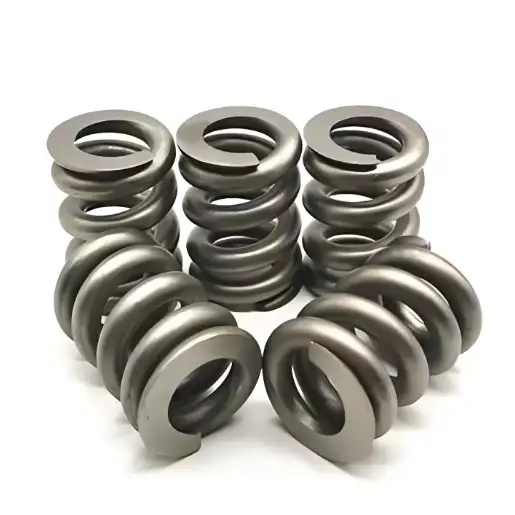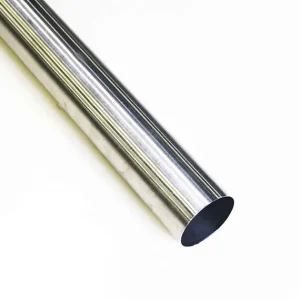Hastelloy B-2 springs are specialized nickel-molybdenum alloy springs designed for extreme reducing environments (notably hydrochloric, sulfuric and other non-oxidizing acids). When engineered and heat-treated correctly, B-2 wire offers industry-leading resistance to uniform and localized attack in chloride-bearing reducing media while providing acceptable mechanical strength for many spring designs; however, it is unsuitable where oxidizing contaminants exist and requires careful thermal control during fabrication and service.
What are Hastelloy B-2 springs?
Hastelloy B-2 (UNS N10665, W.Nr. 2.4617) is a nickel-molybdenum alloy with negligible chromium. It was developed to resist strongly reducing acids (notably hydrochloric acid) across concentrations and temperatures while retaining weldability and good corrosion resistance in the as-welded condition. Springs produced from B-2 wire leverage that chemical resistance to operate in acid contact environments where more common spring alloys would fail from rapid uniform or localized corrosion.
Choose Hastelloy B-2 springs when the service fluid is strongly reducing (e.g., high-concentration HCl, certain sulfuric acid scenarios) and oxidizing impurities (iron(III), cupric salts, dissolved oxygen) are controlled or absent. If oxidizing contaminants are likely, consider C-series Hastelloy (e.g., C-276) or a different material system.
Typical applications and service environments
-
Acid pickling and acid regeneration lines (salt-free HCl service).
-
Equipment in chlorination, refining, and chemical process plants where reducing acids are prominent.
-
Acid-resistant valve internals, seals, and wash-springs inside acid contact equipment.
-
Vacuum furnace components and specialty chemical reactors where reducing atmospheres dominate.
Chemical composition (nominal / typical)
Below is a compact table with the standard compositional windows commonly cited for Hastelloy B-2 (UNS N10665). These values are industry-typical (datasheet ranges and vendor confirmations).
| Element | Typical (wt.%) — Hastelloy B-2 (UNS N10665) |
|---|---|
| Nickel (Ni) | Balance (≈ 60–72 %) |
| Molybdenum (Mo) | 26.0 – 30.0 |
| Iron (Fe) | ≤ 2.00 |
| Chromium (Cr) | ≤ 1.00 |
| Cobalt (Co) | ≤ 1.00 |
| Manganese (Mn) | ≤ 1.00 |
| Silicon (Si) | ≤ 0.10 |
| Carbon (C) | ≤ 0.02 |
| Phosphorus (P) | ≤ 0.040 |
| Sulfur (S) | ≤ 0.030 |
Source: consolidated industry datasheets and material databases. Chemistries vary slightly by mill specification; always confirm the certificate of analysis for a production batch.
Metallurgical note: the high Mo and low Cr make this an exceptional alloy for reducing acids but sensitive to oxidizing contaminants; the low carbon helps prevent carbide precipitation in weld HAZs, enabling good as-welded performance.
Material properties (mechanical & physical)
The table below summarizes commonly reported mechanical and physical properties for typical wrought/annealed Hastelloy B-2. Values will vary by product form (wire, bar, strip) and heat treatment.
| Property | Typical value (annealed, room temp) |
|---|---|
| Density | ≈ 9.22 g/cm³ (9,220 kg/m³). |
| Tensile strength (ultimate) | ~ 800–950 MPa (datasheet dependent) |
| Yield strength (0.2% offset) | ~ 300–450 MPa (depends on product form) |
| Elongation (50 mm) | ≥ ~40–55% (annealed) |
| Modulus of elasticity (E) | ~ 200–220 GPa |
| Hardness (Rockwell B) | typical converted values ≈ ~95–100 RB (Vickers ~240) — see hardness section. |
| Thermal conductivity | ~ 10–12 W/m·K |
| Melting range | ~ 1,330–1,420 °C (depending on batch) |
Note: for spring design you will typically use the spring wire in a cold-worked/heat-treated state to reach the desired modulus and yield; measured tensile and yield vary with cold work and solution annealing.
What is the hardness of Hastelloy B-2 springs?
Typical hardness for annealed Hastelloy B-2 falls around Rockwell B 95–100 (Vickers ≈ 230–250), depending on prior cold work and solution treatment. Cold drawing (spring wire manufacture) increases hardness and tensile/yield strength substantially; the spring maker will quote the work-hardened tensile and yield for the intended wire temp/finish. Always request hardness/tensile on the mill cert if fatigue or seating force is critical.
What is Hastelloy B-2 used for (springs)?
-
Springs that must resist high-concentration reducing acids where stainless steels corrode rapidly.
-
Components in in-line acid dosing equipment, acid vapor handling, and specialized valves in chemical plants.
-
Small, critical closure or preload springs inside acid tanks or reactors where frequent replacement is impractical.
Design caution: because B-2 lacks chromium, it does not protect well against even small amounts of oxidizing species; inclusion of iron/copper contaminant can accelerate attack. Therefore, specify system cleanliness and confirm compatibility before selecting B-2 springs.
Hastelloy B-2 spring equivalents
Common specifications and equivalents used in procurement:
-
UNS: N10665.
-
EN/Werkstoff: DIN W.Nr. 2.4617 (often referenced).
-
ASTM references: alloy forms typically supplied under ASTM B333 (wire/strip), B335 (bars/rods), B366, B564, B619, B622 — verify the specific form and spec when ordering.
Is Hastelloy harder than stainless steel?
Relative hardness depends on alloy and temper. In the annealed condition, many nickel-base alloys (including Hastelloy B-2) present similar or higher hardness than austenitic stainless steels (e.g., 304/316). But spring performance depends on yield strength after cold work. Stainless spring alloys (e.g., 17-7PH, 301, 302) are often supplied in high-strength tempers specifically for springs; those stainless tempers typically deliver higher yield for a given temper than annealed B-2. Therefore, Hastelloy B-2 is superior chemically in reducing acid environments, but stainless spring alloys may outperform B-2 in yield per unit cold work and are generally cheaper. Choose by corrosion environment first, then mechanical needs.
Difference between Hastelloy B-2 and B-3
-
B-2 (UNS N10665): optimized for reducing acids with improved weld HAZ corrosion resistance compared with early Alloy B; strong Mo content, excellent in HCl and many reducing conditions. It can become thermally unstable/embrittled in certain mid-temperature ranges if mishandled.
-
B-3 (UNS N10675): newer generation with better thermal stability, improved weldability and resistance to thermal embrittlement; recommended where B-2 availability or thermal issues are a concern. When in doubt for higher temperature processing or where fabrication heating cycles are likely, B-3 is often the safer choice.
Procurement tip: suppliers sometimes recommend B-3 as a drop-in improvement for many B-2 applications because of fewer fabrication constraints.
Hastelloy B-2 springs — specification & form factors
Common spring products and relevant specs:
-
Wire types: round wire is standard for coil springs; flat strip can be formed into leaf or flat springs.
-
Standard product forms: wire (drawn and finished), strip, bars, rods, plate (for other parts). Wire may be supplied in annealed or work-hardened conditions.
-
Standards to reference on PO: UNS N10665; ASTM B333 for strip/coil/wire; confirm mill cert to ASTM A370/B standards where mechanical testing is requested.
Size & weight: practical spring wire values
Formula (round wire): mass per meter (kg/m) = π × (d/2)² × density. Use density = 9.22 g/cm³ = 9,220 kg/m³ (typical for B-2).
Examples (diameter → mass per meter):
| Wire diameter (mm) | Mass per m (kg/m) |
|---|---|
| 0.5 mm | 0.001810 kg/m |
| 1.0 mm | 0.007241 kg/m |
| 2.0 mm | 0.028965 kg/m |
| 5.0 mm | 0.181034 kg/m |
| 10.0 mm | 0.724137 kg/m |
| 20.0 mm | 2.896548 kg/m |
How these numbers were computed (brief): for 1.0 mm wire: radius = 0.0005 m → area = π×(0.0005)² = 7.85398e-7 m² → mass/m = area×9,220 kg/m³ ≈ 0.007241 kg/m. (All diameters calculated with the same method.) These sample figures help procurement estimate coil weights, spool sizes, and per-coil pricing.
Manufacturing & spring design notes
-
Wire procurement: order near-net diameter with stated tensile/yield and mill cert. Specify whether annealed or cold-drawn finish is required.
-
Cold forming: B-2 is formable but work hardens; multiple cold forming passes and intermediate stress-relief anneals may be necessary for tight-tolerance helix springs.
-
Heat treatment: solution anneal per mill recommendations (commonly ~1065 °C for solution treatment) followed by rapid quench for certain product forms. Avoid long exposure in embrittlement-range temperatures (mid-T intervals reported as potentially problematic without correct processing).
-
Welding and joins: B-2 tolerates welding well in many conditions and resists weld HAZ attack—one reason it was developed. When spring geometry requires welding, specify post-weld testing.
-
Fatigue: experience shows nickel-base springs often have lower shear modulus than steels; design with adequate safety factors and validate life by testing in simulated media. Surface finish and shot-peening of spring surfaces improve fatigue life.
-
Cleaning & system compatibility: eliminate oxidizing contaminants (Fe³⁺, Cu²⁺) from process streams; even tiny amounts can shift corrosion behavior. If contamination risk exists, specify a different alloy family.
Global price snapshot 2025
nickel-base alloy pricing moves with global nickel/molybdenum markets, form factor (wire vs bar vs sheet), minimum order quantity, and producer. The table below gives indicative 2025 price ranges (USD per kg) for Hastelloy family product forms sourced from Chinese & international suppliers — these are procurement starting points; request quotes and mill-certs for exact pricing.
| Product form | Indicative price range (USD/kg) — 2025 |
|---|---|
| B-2 round bar / rod | USD 100 – 300 / kg (size, quantity dependent) |
| B-2 wire (small coil, <100 kg) | USD 150 – 400 / kg (drawing & finishing premium) |
| B-2 strip / sheet | USD 120 – 350 / kg |
| Specialty spring assemblies (heat-treated, finished) | Project quote — tooling & processing add significant cost |
Notes & sourcing: Chinese suppliers list wide price spreads on platforms (Alibaba, Made-in-China) that reflect small-order retail vs wholesale mill supply; larger volume direct mill orders reduce per-kg cost substantially. Always request current mill certificates (CoA) and confirm form/tolerance.
Why MWAlloys for Hastelloy B-2 springs?
-
Factory direct: MWAlloys is a Chinese manufacturer with in-house spring forming and finishing lines; this enables 100% factory pricing (no middleman premium).
-
Stock & speed: we keep selected Ni-Mo alloy wire in stock for fast turnarounds on small to medium orders; large bespoke runs are scheduled per agreement.
-
Quality & traceability: full mill certs (UNS, chemical, mechanical) and test reports supplied with each shipment.
-
Engineering support: we provide spring stress analysis, life estimation, and chemical compatibility checks for acid environments to reduce field failures.
FAQs
-
Can Hastelloy B-2 springs be used in sulfuric acid?
Yes for many concentrations and temperatures, but validate for specific concentration/temperature and check for oxidizing impurities. -
Are B-2 springs weldable?
Yes, B-2 was engineered for good as-welded performance; however, welding may change local properties—specify post-weld inspection. -
What temperature limits apply?
Short-term use can extend to several hundred °C, but avoid mid-range temperatures that can induce embrittlement if not processed correctly; if elevated temperature service is anticipated, consider B-3. -
Do you have standard spring sizes?
MWAlloys produces common coil diameters and wire sizes (0.2 mm–10 mm commonly available); custom sizes made to order. -
Will B-2 rust like steel?
B-2 does not rust like carbon steel, but it may corrode if oxidizing species are present; specify process chemistry. -
Is Hastelloy B-2 magnetic?
Typically weakly magnetic or non-magnetic in annealed condition; some cold work may alter magnetic response slightly. -
What test certificates are provided?
Chemical analysis (CoA), mechanical test data and, on request, hardness and tensile results per ASTM/EN protocols. -
Can B-2 be used in seawater?
No, B-2 is not intended for oxidizing chloride environments where C-series alloys or duplex stainless steels would be better. -
How do I specify springs on a PO?
Give wire alloy/UNS, wire diameter, coil OD, free length, spring index, number of coils, finish, and required mill certs. -
Are there cheaper alternatives?
For less corrosive or oxidizing environments, stainless spring alloys (17-7PH, 302/304/316) or Inconel types may be more cost-effective. Select materials by chemical compatibility first.





